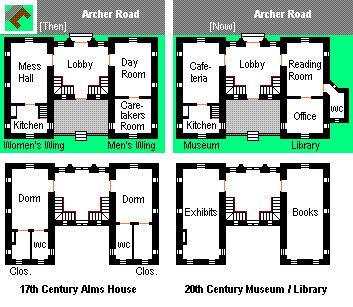

The Almshouse was built in 1637 by Sir Charles de Courtenay, Baron Rapnel, as a place to dump his superannuated servants and other penurious old villagers. It consisted of a men's wing and a women's wing, with a 'soup kitchen' and common room on the ground floor and spaces for about thirty bunked beds upstairs. Not a very comfortable place, but poverty has never been comfortable. But the construction was good, if simple, using good cut limestone (much of it looted from the outer ward of the castle) and solid oak from Fairwood. The place functioned as an alms house until 1920, when it was converted into a museum and library. Note the fine two-storied lobby hall with its lantern at the top.
The library consists of a reading room with newspapers, periodicals, and popular current books. Above, in the old men's dormitory, is the stack room, with a fairly large collection of books -- mostly tracts and sermons and memoirs donated from the Manor library. Also on the ground floor is a modern cafeteria occupying the site of the original mess hall and kitchen. This is a popular place for the elderly of the village to spend their days. Our librarian is Mr Thwaitmar, who has been in the post for some 25 years after the death of his predecessor who 'founded' the library, Arnold Lamber.
The museum is simply a single large room that contains a diverse collection of antiquities from the neighborhood, mostly old agricultural machinery of now unknown use. Some suits of armor occupy the lobby. The front section of the museum has a collection of old photographs taken locally. There is a vaulted cellar under the cafeteria that is used to store unexhibited pieces from the museum collection. Mr Thwaitmar also serves as curator for the museum, which of course is free and open to the public. Tourists don't seem to waste much time here, spending an average of five minutes per visitor.
It is a pity, in a way, that so little interest is taken in this evidence of our local heritage. However, I should be the first to admit that a rusted old crop harrower is not the most interesting of exhibits. Much more to the public taste is the museum in the Castle gatehouse, which is one of those slick productions of British Heritage showing medieval castles of the area in all their barbaric militancy. And not to be missed is of course the collection of antique steam road vehicles at the Manor House.
![]() The basement under the Cafeteria, where excess museum relics are stored, is haunted by a rather repulsive ghost or some such praeternatural elemental. I have written a small Chapbook on this subject, which, when I get round to it, will be located on a web page entitled 'Tuesday's Ghost'. -- Rev. B. Humbleside
The basement under the Cafeteria, where excess museum relics are stored, is haunted by a rather repulsive ghost or some such praeternatural elemental. I have written a small Chapbook on this subject, which, when I get round to it, will be located on a web page entitled 'Tuesday's Ghost'. -- Rev. B. Humbleside